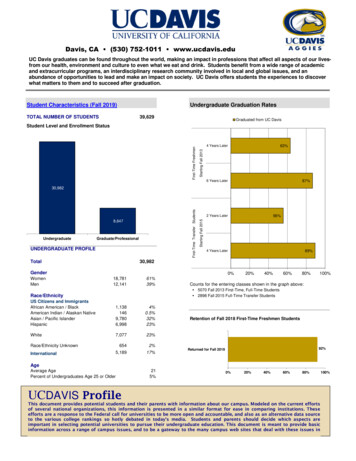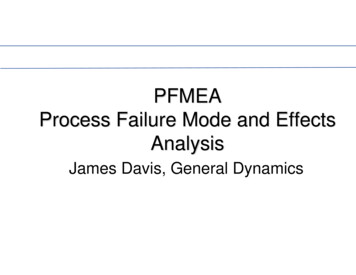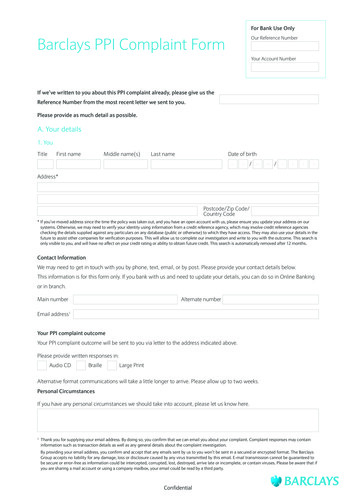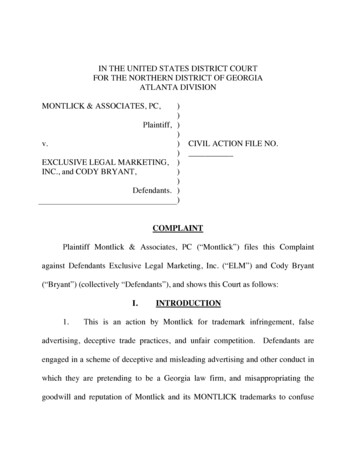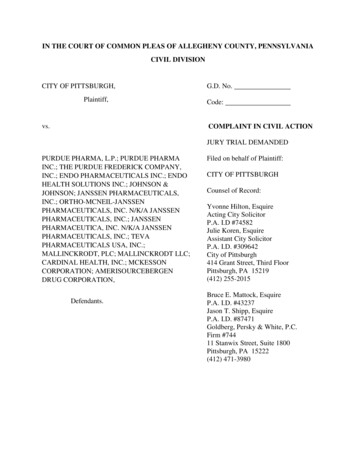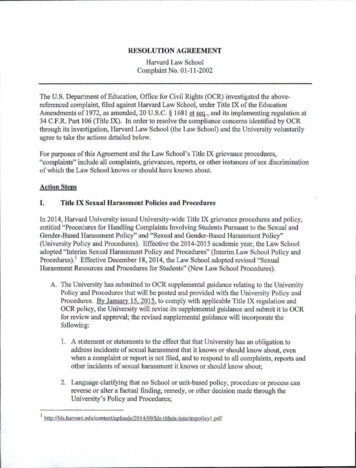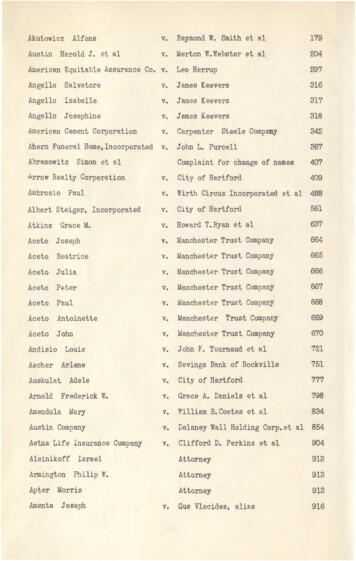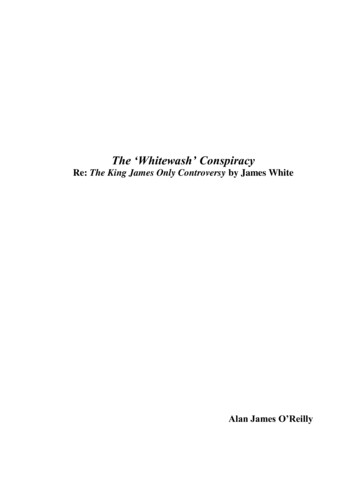
Transcription
Case 6:11-cv-01440-GKS-GJK Document 1Filed 08/29/11 Page 1 of 23 PageID 1UNITED STATES DISTRICT COURTMIDDLE DISTRICT OF FLORIDA L"l:ORLANDO DIVISION1',"" ,,:' 'liSP !eT OF ;';CASE NO.:SECURITIES AND EXCHANGECOMMISSION,)))Plaintiff,MiG 29 PH I: II:3T;;rG, couln \ \ - C-\) ,., 4 0 -0 r \ - I G-.) k))v.))JAMES DAVIS RISHER andDANIEL JOSEPH SEBASTIAN,)))Defendants.))COMPLAINTPlaintiff Securities and Exchange Commission alleges:INTRODUCTIONI.From no later than January 2007 through July 20 I 0, Defendants James Davis Risherand Daniel Joseph Sebastian operated a Ponzi scheme and raised approximately 22 million frommore than 100 investors nationwide and in Canada. Many of these investors were Florida teachersand retirees.The Defendants purportedly operated a private fund marketed under the names"Managed Capital Fund," "Safe Harbor Private Equity Fund," and "Preservation of Principal Fund"(collectively, the "Fund").2.Risher and Sebastian represented to investors the Fund would only be used forinvestments in equities through a FINRA-regulated clearinghouse. In reality, Risher invested only afraction of investor funds in equities through a broker-dealer.majority of the money for personal use.Instead, he misappropriated the
Case 6:11-cv-01440-GKS-GJK Document 13.Filed 08/29/11 Page 2 of 23 PageID 2Throughout the fraud, the Defendants made materially false and misleadingrepresentations and omissions regarding the Fund's investment strategy, the safety of investing inthe Fund, the existence of audited financial statements, and the investment returns. Additionally,Risher did not disclose to investors he spent 11 of the last 21 years in state and federal prisons afterbeing convicted of numerous crimes including securities and mail fraud.4.As a result of the conduct described in this Complaint, the Defendants violatedSections 5(a) and (c) and 17(a) of the Securities Act of 1933 ("Securities Act"), 15 U.S.C. §§77e(a)and (c) and 77q(a); and Section lO(b) and Rule 10b-5 of the Securities Exchange Act of 1934("Exchange Act"), 15 U.S.C. §78j(b) and 17 C.F.R. §240.10b-5. Risher and Sebastian also aidedand abetted the Fund's violations of Section 10(b) and Rule IOb-5 of the Exchange Act, 15 U.S.C.§78j(b) and 17 C.F .R. §240.1 Ob-5. Risher additionally violated Sections 206( 1), 206(2), and 206(4)of the Investment Advisers Act of 1940 ("Advisers Act") and Rule 206(4)-8 of the Advisers Act, 15U.S.C. § 80b-6(1), 80b-6(2), and 80b-6(4) and 17 C.F.R. § 275.206(4)-8 and Sebastian aided andabetted Risher's violations of Section 206(4) and Rule 206(4)-8 of the Advisers Act, 17 C.F.R. §275.206(4)-8.5.The Commission requests that the Court enter:(I) a permanent injunctionrestraining and enjoining Risher and Sebastian from violating the federal securities laws; (2) anorder directing Risher and Sebastian to disgorge all profits or proceeds they received as a result ofthe acts and/or courses of conduct complained of, with prejudgment interest; and (3) an orderdirecting Risher and Sebastian to pay civil money penalties.DEFENDANTS6.Risher is a resident of Sanibel, Florida. He was the Fund's sole trader and has anextensive criminal history, including the following:2
Case 6:11-cv-01440-GKS-GJK Document 17.Filed 08/29/11 Page 3 of 23 PageID 3 In January 1990, Risher pled guilty to 20 counts of theft by taking in Fulton County,Georgia. The court sentenced him to ten years in prison. In February 1990, Risher pled guilty to a bad check offense in the Superior Court ofGwinnett County, Georgia. The court sentenced him to twelve months to runconsecutively with the sentencing detailed in the September 1990 offense below. In September 1990, Risher pled guilty to three counts of theft by taking and two countsof violating the Georgia Securities Act in the Superior Court of Cobb County, Georgia.The court sentenced him to ten years in prison. In November 1990, Risher pled gUilty to two counts of violating the Georgia SecuritiesAct and two counts of theft by taking in the Superior Court of Houston County,Georgia. The court sentenced him to five years in prison. In November 1996, Risher pled guilty to one count of mail fraud, one count of federalsecurities fraud, and two counts of money laundering in the Middle District of Florida.The court sentenced him to 92 months in prison.Sebastian is a resident of Celebration, Florida.He does business under theunregistered, fictitious name of "Safe Harbor." Until April 2004, Sebastian operated an insuranceagency in Florida. He represented himself to investors as the principal and manager of the Fund'soperations.JURISDICTION AND VENUES.This Court has jurisdiction over this action pursuant to Sections 20(b), 20(d) and22(a) of the Securities Act, 15 U.S.c. §§ 77t(b), 77t(d) and 77v(a); Sections 21 (d) and 27 of theExchange Act, 15 U.S.C. §§ 7Su(d) and 78aa; and Section 214 of the Advisers Act, 15 U.S.c. §SOb-14.9.This Court has personal jurisdiction over the Defendants and venue is proper in theMiddle District of Florida because many of the Defendants' acts and transactions constitutingviolations of the Securities Act, the Exchange Act, and the Advisers Act occurred in the MiddleDistrict of Florida. For example, the Defendants held promotional events for the Fund in Orlando3
Case 6:11-cv-01440-GKS-GJK Document 1and Lakeland.Filed 08/29/11 Page 4 of 23 PageID 4In addition, the Defendants reside in the Middle District of Florida, and SafeHarbor's office was located in the Middle District of Florida until it closed in September 2010.10.In connection with the conduct alleged in this Complaint, the Defendants, directlyand indirectly, singly or in concert with others, made use of the means or instrumentalities ofinterstate commerce, the means or instruments of transportation and communication in interstatecommerce, and the mails.FACTUAL ALLEGATIONSA.The Fund OfferingII.The Defendants met through a mutual acquaintance in 2006 and established the Fundin 2007. Beginning in early 2007, they touted themselves in Fund offering documents as "twounique individuals" who used their expertise to "create an investment vehicle that would allowinvestors to capitalize from both bull and bear markets." They encouraged investors to purchaseshares in the Fund that would purportedly provide a pro rata share of the Fund's profits.12.In early 2007, Risher gave Sebastian several sets of offering materials for theManaged Capital Fund, to use to solicit investors into the Fund. Risher and Sebastian used theseoffering materials to seek investors from 2007 through early 2010. They then prepared substantiallysimilar offering materials and changed the name of the fund to the "Safe Harbor Private EquityFund."13.The Fund offered three investment strategies at varying levels of risk. Risher andSebastian claimed the Fund invested in blue chip stocks, exchange-listed equities, options, and otherinvestment vehicles, depending on the strategy employed. The Fund's stated goal was to achieveannualized returns ranging from 12% to 51 % using the three strategies.The Fund's offeringmaterials boasted a successful history of net returns ranging from 14% to more than 124% annually,4it 4;S:W",.,Iv.SQ.(;;:;:g;.dOvQ.v.S.J.J,Oi.(((. 111 ,;g;;:c"gm.m i('liW14@mq.&G!E!Q4wum. h m .1 th . t I.5 ! t .t 2.!3 (.2( ,1 .'"
Case 6:11-cv-01440-GKS-GJK Document 1Filed 08/29/11 Page 5 of 23 PageID 5dating back to 2000, when Risher claimed he operated the Fund under the name "Managed CapitalFund."14.The offering materials stated the management fee was 2% of assets undermanagement and the performance fee was 20% of profits. Sebastian and Risher split the feesequally and Risher wired Sebastian his portion on a quarterly basis.15.From 2007 through July 20 I 0, Sebastian solicited his former insurance customers,educators, retirees, and members of several churches in Florida. During the same time period, healso solicited investors in California, other states, and Canada. Sebastian persuaded his formercustomers to roll over the funds in their insurance and annuity products into the Fund. He told hiscustomers the Fund would provide a higher rate of return than they could receive from the productshe had previously sold them. At least one investor liquidated an annuity she had purchased fromSebastian and invested the proceeds in the Fund.16.Defendant Risher, for compensation, engaged in the business of advising others, eitherdirectly or through publications or writings, as to the value of securities or as to the advisability ofinvesting in, purchasing, or selling securities, including shares of the Fund.17.Investors in the Fund purchased shares purportedly representing a pro rata slice ofthe Fund. No registration statement was filed or in effect with the Commission pursuant to theSecurities Act with respect to any offering of the Fund.18.From 2007 through July 2010, Sebastian provided investors with Fund offeringmaterials and drafted and electronically signed Fund newsletters, which touted Risher's trading skilland substantial investment experience.Sebastian distributed Fund newsletters on at least thefollowing dates:October 9,2007December 4, 2007October 15, 2008June 16, 20095
Case 6:11-cv-01440-GKS-GJK Document 1Filed 08/29/11 Page 6 of 23 PageID 6July 10, 2009June 15,2010July 12,2010August 23, 20 10August 25,2010January 7, 2008February 7,2008September 17,2008September 25, 2008October 8, 2008Sebastian also sent out undated newsletters, which he drafted and electronically signed, to investorsin December 2008 and the fall of2009.19.In early 2010, Sebastian gave investors a DVD containing, among other things, videotestimonials about Sebastian and Safe Harbor from other investors.20.Also in early 2010, Risher solicited new investors and told at least one prospectiveinvestor during a telephone call he was in charge of trading securities for the Fund. He described tothis investor the trading strategies the Fund employed and represented it had yielded an annualreturn of 19% in 2007.21.Throughout the fraud, Sebastian also hosted numerous annual golf tournaments andother promotional events for investors, which Risher sometimes attended. At an investor event heldon March 12 through 14, 2010 at an Orlando resort, Sebastian told investors in a speech, "[Y]ouinvest in this fund and all of a sudden you start making more money than you've ever made in yourlife with your investors. And then all of a sudden you start making enough money where you don'thave to go to work . [a]t Safe Harbor, you could retire today, like right now. And I'm telling you,you get rid of the struggle."22.Risher also spoke to investors at this meeting, saying his job was to "keep us whatwe like to call market neutral, and that means that we have the ability to profit hopefully on theupside as things go up and to try to remain with a bias toward things unexpectedly going bad andgoing short when things go down." Sebastian recorded his speech and included it along withinvestor testimonials in offering materials he distributed to existing and prospective investors.6
Case 6:11-cv-01440-GKS-GJK Document 123.Filed 08/29/11 Page 7 of 23 PageID 7Sebastian directed investors to send their investments by wire or check to a bankaccount in the name of Jade Asset Group, which was under Risher and his wife's exclusive control.Some investors also made their investment checks out to Capital Trading Partners, LLC, ManagedCapital, LLC, and Isle FX Trading, LLC, all controlled by Risher. Risher signed and sent investorsconfirmations for the receipt of their funds. Investors understood their funds purchased purportedshares in the Fund. Many investors rolled over their retirement savings. At least two investorsdrew on their home equity lines of credit to invest in the Fund, relying on the Defendants'representations of the Fund's safety and success.24.Contrary to the stated strategies of the Fund, Risher placed only 2.5 million of the 22 million he and Sebastian raised in brokerage accounts for trading. Furthermore, bank andbrokerage records indicate Risher lost 890,000 of the 2.5 million invested through his tradingactivity.25.Instead of investing investor funds as promised, Risher and Sebastian paidthemselves purported management and performance fees of 4.8 million and 3.3 million,respectively.Based on the performance of the Fund. these payments were not due to theDefendants. They also used the money to honor periodic distribution and redemption requeststotaling approximately 3.6 million between January 2007 and July 2010. Additionally, Risherused another 4.5 million of investor funds for jewelry, gifts, purchases of real property in NorthCarolina and Florida, and personal expenses such as credit card and property tax payments.26.During the scheme, Sebastian sent investors account statements showing purportedquarterly returns ranging from 2.28% to 5.64%.The quarterly statements displayed accountbalances and percent returns, but contained no information about specific trades or securities held,and never showed losses. Without seeing records of the supporting trading activity or a complete7
Case 6:11-cv-01440-GKS-GJK Document 1Filed 08/29/11 Page 8 of 23 PageID 8list of the Fund's holdings, Sebastian generated the statements using purported percentage returnsfor each of the Fund's strategies that Risher sent him through email or text messages. He alsocalculated the Defendants' management and performance fees based on these communications fromRisher.27.Additionally, Sebastian and sent investors periodic newsletters, which he drafted andsigned, reporting on the Fund's returns and operations.For example, in the October 8, 2008newsletter, Sebastian told investors "we will preserve your principle [sic] at all cost."In theDecember 2008 newsletter, he told investors he "made sure before a single dollar went into thePrivate Equity Fund that [Risher] was not to trade at more than I: I [leverage] except with rareexception." Sebastian repeatedly touted Risher's trading expertise and ability, as well as the Fund'ssuccess in comparison to other investments. The same December 2008 newsletter said, "no matterwhich way the market goes, you can see why [Risher) has never had so much as a down quarter forthe entire life of the fund which has been in existence for going on nine years now."28.In the fall 2009 newsletter, Sebastian also discussed specific trades the Fund hadpurportedly made and told investors he spent three weeks in September 2009 sitting next to Risherand observing his trading.B.The REIT Offering29.From no later than December 2009 through January 20 I0, the Defendants alsosolicited investors to invest in the Safe Harbor Real Estate Investment Trust ("REIT") bypurchasing shares of the REIT. Sebastian told investors via telephone calls, e-mail, and in-personmeetings, Risher was going to use investor proceeds to fund the purchase of distressed real propertyat a discount and investors would profit from the sale of the property. Investors received statementsreflecting only that they had invested in a "Real Estate Asset Management Trust" and containing no8
Case 6:11-cv-01440-GKS-GJK Document 1Filed 08/29/11 Page 9 of 23 PageID 9other information about the investment. The supposed minimum investment was 100,000, andinvestors could roll 50,000 over from the Fund into the REIT program.Investors made theirchecks for the balance out to Isle FX Trading.30.The Defendants raised more than 890,000 from 13 investors in the REiT offering.Instead of using the funds to invest in a REIT, Risher transferred them into a brokerage account andlost more than 71,000 through trading equities. He transferred more than half of the remainderinto several bank accounts he controlled and spent the rest by June 2010 on jewelry, electronics,foreign currency, payments to a construction company, and other personal expenditures.c.Roles of Sebastian and Risher31.From 2007 through July 2010, Sebastian distributed offering materials to investorsrepresenting Sebastian as the Fund's managing partner and Risher as responsible for handling thetrading operations.In reality, Risher alone had control over nearly all aspects of the Fund,including managing investor funds. Sebastian's primary activities were marketing the Fund andcorresponding with investors. Sebastian did not have access to the bank or brokerage accountswhere investor funds were held, and Risher denied him access when requested.Instead, Risherwould transfer investor funds to accounts held by Preservation of Principal, LLC and LBT Group,Inc., both entities Sebastian controlled.Sebastian received his share of the management andperformance fees through the LBT Group account.32.During the scheme, Risher was frequently late in wiring the distribution funds andhis share of the performance fee. Sebastian questioned Risher about the reasons for the delays onnumerous occasions. Risher blamed the delays on an inability to liquidate the funds on time orincorrect wiring instructions. In one instance in late 2007, Sebastian emailed Risher in reference toRisher's late wires, saying he was acting more like a rookie than an experienced trader. In October9
Case 6:11-cv-01440-GKS-GJK Document 1Filed 08/29/11 Page 10 of 23 PageID 102009, Sebastian asked Risher to add him as an authorized agent on all accounts associated with theFund so he could have some control over the timeliness of the funds disbursed to the Preservation ofPrincipal bank account for investor distributions. Risher never gave him access.33.In middle 2008, Risher provided Sebastian with two sets of false financial statementsfor the Fund. These documents were purportedly financial statements for Jade Asset Group andprofessed to have been audited by an auditing firm out of Bermuda, which in fact did not exist. Thepurported audit opinion letter accompanying the statements stated the audit was conducted "inaccordance with the standards of the Public Company Accounting Oversight Board (UnitedKingdom)," which did not exist.These statements improperly reported investor deposits asrevenues instead of capital contributions. Furthermore, each of the documents purported to be an"annual" financial statement, but they were issued only six months apart. Finally, the statementscontained many references to irrelevant facts apparently copied from another source, such asexecutive compensation, stockholders and stock option plans, a failed corporate acquisition, thecompany's board of directors, and its earnings per share.34.In August 2009, Risher provided Sebastian with another set of fabricated financialstatements for the Fund.Entitled "Capital Trading Partners, LLC Assembled FinancialStatements," they covered the period from January I to April 30, 2009, but did not mention theFund's name. These statements stated they "are not prepared with an expression of any form ofoption or assurance and they are prepared by an entity that is not licensed by the Florida Board ofAccountancy." The statements reflect a beginning capital balance of approximately 4.5 million(which was almost 10 million less than Risher and Sebastian had raised at the time) and an endingbalance of 0. Risher told Sebastian these later statements were for Strategy One's invested assetsbut not its cash positions.10.ii t t n d1a.twtI.UM, iSH . wn 1(1H!Ii(.4 .i.n.S.ShOS. . ".".it.) IWUW . "M . ",JiiiiiMvJv.& ,( ; PiMlW«i .Wi#i,s . W.J.&'& . h.i .&tt.44 MM,J"tGZ,J.J.&. iit.5.tttt.t. ( ht:w x·
Case 6:11-cv-01440-GKS-GJK Document 135.funds.Filed 08/29/11 Page 11 of 23 PageID 11In May 20 10, Sebastian became further concerned with Risher's handling of investorRisher had sent two checks totaling 125,000 directly sent to an investor to cover theinvestor's withdrawal request, but the checks were returned for insufficient funds. He ultimatelypaid the investor, but did so in three installments over two months.36.Risher provided Sebastian with very limited financial and trading records for theFund, and when he did, they were fabricated. On several occasions, Risher substituted the Fund'sbrokerage records with records for another brokerage account over which he had discretionarytrading authority. The account belonged to an unrelated entity and did not contain any moneybelonging to Fund investors.For example, on August 19, 2009, Risher gave Sebastian twobrokerage account summaries from this unrelated account with the brokerage account names andnumbers redacted, along with a small accompanying list of purported trades, for use in preparing tosolicit two prospective investors into the Fund.37.Toward the end of the scheme in July 2010, Sebastian again asked Risher for theFund's brokerage records and Risher provided him with more false documentation in the form ofseveral screenshots of unrelated brokerage accounts balances for the Fund, totaling 21.3 million.These screenshots did not indicate dates or account numbers.MISREPRESENTATIONS AND OMISSIONS38.From 2007 through July 2010, Risher and Sebastian made a number of material falsestatements and omissions to investors regarding, among other things, the Fund's investmentstrategy, Risher's criminal history, the safety of investors' principal, the existence of auditedfinancial statements, and the Fund's investment returns.II
Case 6:11-cv-01440-GKS-GJK Document 1A.Filed 08/29/11 Page 12 of 23 PageID 12Misrepresentation of Investment Strategy39.Risher and Sebastian misrepresented to investors the Fund's investment strategyconsisted of trading in equities, and failed to disclose they were operating a Ponzi scheme.40.Risher acted as the primary drafter of the written offering materials, which Sebastiandistributed to investors. The written offering materials describe the Fund's three strategies fortrading equities through a FINRA-registered clearinghouse.Sebastian repeatedly discussed theFund's trading activity in newsletters he drafted, signed, and sent to investors. Furthermore, Rishergave a speech to investors at a Fund event in Orlando, Florida in March 2010, briefly explaining hisequity trading strategy.41.Risher knew the statements about trading were false. He knew the Fund had nomeaningful source of income other than money from new investors because he had deposited only asmall fraction of the 22 million raised into brokerage accounts and conducted minimal tradingactivity.42.Sebastian held himself out to investors as the manager of the Fund's operations butnever acted in this capacity and ignored several red flags about the veracity of the statements. First,he never saw any complete brokerage statements for the Fund or list of the Fund's investmentholdings. Second, the limited brokerage records he did see were redacted, incomplete, and reflectedsignificantly less than what he knew the full balance of the Fund's assets should have been at thetime.B.Failure to Disclose Risher's Criminal History43.From 2007 through July 2010, Risher knowingly misrepresented to investors hiscriminal and business background. Risher's biography, which he wrote and included in the Fund'soffering materials, misrepresented him as, among other things, having worked for a brokerage firm12. t2 i L. ithWh: t mmt:W"MAtI.u",m.e.&.s.s. , . J.t9CN!J3((. .t,dS,W&.;.tS.z. ".t.t.hUr h.t.X . 1- ((.M .S& .t U.J a t . ts&3},J.3. .(@iti&lS!C,CP./).!i MMl4AM&GAWA!6!d1t. :
Case 6:11-cv-01440-GKS-GJK Document 1Filed 08/29/11 Page 13 of 23 PageID 13between 1977 and 1998, and owning retail brokerage and wealth and asset management businesses.The Fund's written offering materials also contained fictitious historical returns of the Fund in thematerials dating back to 2000. In reality, Risher spent almost four years between February 1990and November 1993 in prison, in part for convictions in 1990 based on violations of Georgiasecurities laws. He later spent almost seven years between February 1996 and October 2002 in afederal penitentiary in Florida for a conviction in 1996 on violations of the federal securities laws.He was incarcerated once more in 2003 for a probation violation in Georgia.Risher did notdisclose to investors that for at least six of the 21 years between 1977 and 1998, during which hewas purportedly growing a "thriving" retail brokerage business, he was actually in prison forsecurities fraud.Furthermore, Risher has actually never held any securities licenses nor beenassociated with or owned a registered broker-dealer.c.Misrepresentation of the Safety of the Investment44.From 2007 through July 20 I 0, Sebastian orally told several investors duringtelephone calls and in-person meetings they would never lose their principal investments in theFund. He also provided some investors with written guarantees from Safehaven Inc., a company hewholly owned, claiming all money deposited into the Fund would be guaranteed against loss, andthat Safehaven would reimburse any loss. According to the guarantee, which he drafted and signed,Sebastian, as Fund manager, was required to keep a stop loss on all active trades placed in the Fund,and the Fund was required to maintain a certain cash reserve at all times.45.Sebastian's oral and written guarantees were baseless. He had no basis to claiminvestors would not lose their principal in a fund that day traded public equities. Second, Sebastianknew Safehaven had no assets to reimburse investors for losses, making his guarantee meaningless.13
Case 6:11-cv-01440-GKS-GJK Document 1Filed 08/29/11 Page 14 of 23 PageID 14Third, Sebastian, knew he had no access to the Fund's brokerage accounts to be able to place a stoploss on the trades or to verify the Fund maintained the appropriate cash reserve, which it did not.46.In the spring of 2009, Sebastian signed and sent a newsletter to investors claiminginvestors' funds were safe and assuring them that if Risher ever tried to "abscond with all themoney in the fund, [Sebastian] would very quickly see what was happening.'" Sebastian toldinvestors in another newsletter he signed that "[Risher], as well as my self[sic], along with a teamof other people have the ability to, at any time, go into the books and make certain that everything isin order and according to what is being reported to the members." Sebastian knew this was falsebecause he did not have access to the bank or brokerage accounts where investors' money waspurportedly held.47.The written offering materials Risher drafted also misrepresented to investors all theFund's assets were held at, and all trades were cleared through, a FINRA-registered clearinghouse.Risher sent at least one investor a letter he signed stating the investors' funds would be "[p]rotectedat all times by Securities Investor Protection Corporation ("SIPC") for the full amount of [his]principal balance," although this "does not insure against losses incurred in the trading process, onlyagainst theft, fraud, andmalfea ance."Risher knew these statements were false because he haddeposited only a small fraction of the 22 million raised into brokerage accounts that SIPC insured.Sebastian knew or was extremely reckless in not knowing these misrepresentations in the offeringmaterials he distributed were false because the limited brokerage records he saw reflectedsignificantly less than what the full balance of the Fund's assets should have been at the time.Furthermore, he ignored the red flags that the brokerage records were redacted and incomplete.48.Finally, the offering materials misrepresented the Fund was registered in Bermuda.It was not.14
Case 6:11-cv-01440-GKS-GJK Document 1D.Filed 08/29/11 Page 15 of 23 PageID 15Misrepresentation of Existence of Audited Financial Statements49.The Fund's offering materials, which Risher drafted and Sebastian distributed, alsofalsely represented the Fund's results were audited and verified by Capital Requirements, Ltd., ofHamilton, Bermuda. No such entity has ever registered or been incorporated in Bermuda. Risherknew these statements were false.50.Sebastian further signed and distributed a newsletter to investors in 2009 claimingthe Fund "is audited by an organization in Bermuda and every line item is looked at closely andscrutinized."51.Sebastian knew or was extremely reckless in not knowing the Fund did not haveaudited financial statements for several reasons. First, the only financial documents he saw coveredonly the brief period from January 2007 to March 2008, and he ignored red flags that these werefake. Second, the remaining financial documents he saw covered the period from January to April2009, and indicated on their face they were not audited.Finally, at no point during theapproximately 3 Y2 years he was involved in the Fund did he see an audit engagement letter, speakwith any auditor, or provide any auditors with information pertaining to the Preservation ofPrincipal distribution account, to which only he and his assistant had access.E.False Account Statements52.Risher and Sebastian lulled investors with false account statements, reflecting annualreturns of at least 14%. These statements, which Sebastian prepared and distributed based onperformance figures Risher sent him each reporting period, had no basis. Risher knew, based on hiscontrol of the Fund's bank and brokerage accounts, the Fund's returns he provided Sebastian werefalse.15. IJS6t.ti.a.a.sm! sa.U.c. (it,4iiMiMi.'M . 444kGtmt:4!W.44A%WZ:O.o.s .m:a:t: .t t. . t tWt.J2.iik.t.h .(I! ::nh4.4it;i4iM«At:amWhP!t lith··
Case 6:11-cv-01440-GKS-GJK Document 153.Filed 08/29/11 Page 16 of 23 PageID 16Sebastian knew or was extremely reckless in not knowing the returns in the accountstatements were false.He simply entered the percentage returns he obtained from Risher intocomputer software to generate the investor statements. He then sent them to investors withoutquestioning why there were never any losses after the market downturn during the scheme. Nor didhe ever see brokerage statements, a complete list of investment holdings, or any
dating back to 2000, when Risher claimed he operated the Fund under the name "Managed Capital Fund." 14. The offering materials stated the management fee was 2% of assets under management and the performance fee was 20% of profits. Sebastian and Risher split the fees equally and Risher wired Sebastian his portion on a quarterly basis.

